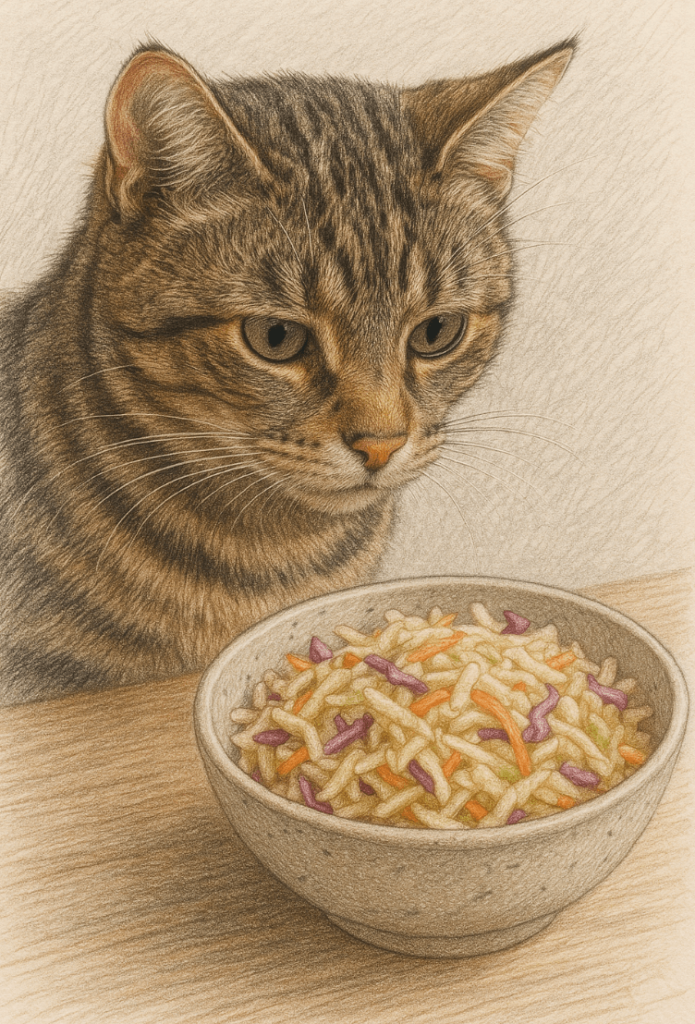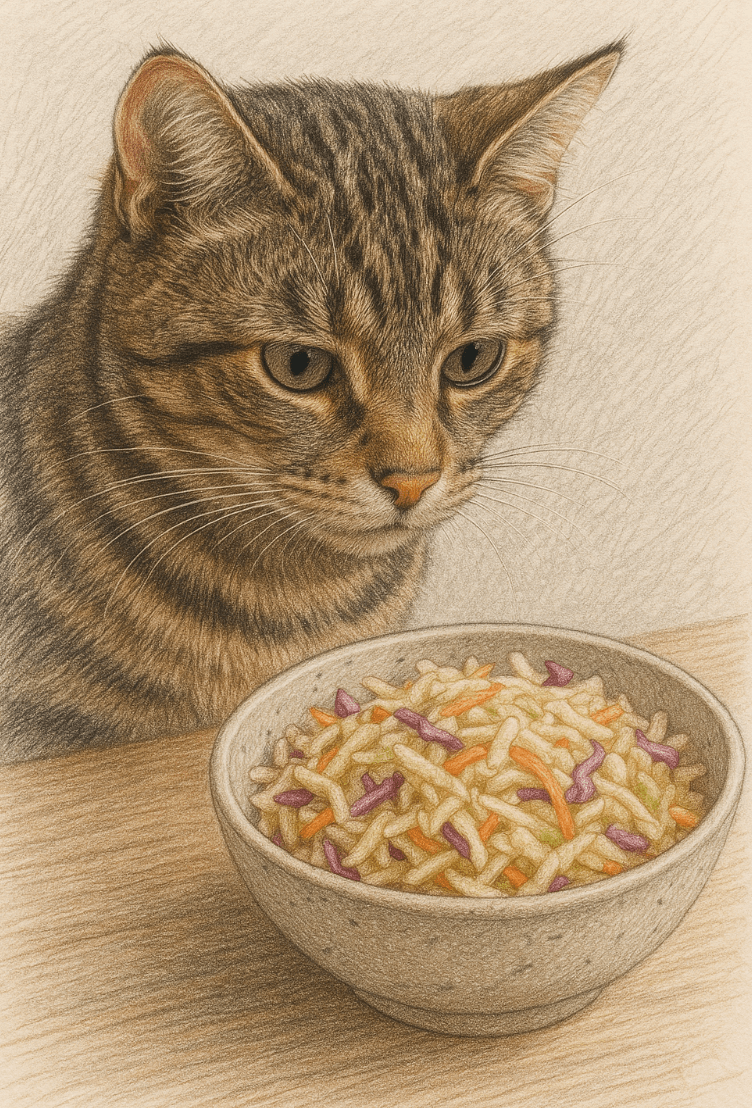Can Cats Eat Coleslaw? What You Need to Know
Cats are naturally curious creatures, and their penchant for sniffing out human food can sometimes leave pet owners wondering whether certain foods are safe for them. Coleslaw, a popular side dish made from shredded cabbage and often mixed with dressings, is one such food that might catch your cat’s attention. But can cats eat coleslaw? While some ingredients in coleslaw may seem harmless, others could pose risks to your feline friend. In this blog post, we’ll explore the safety of feeding coleslaw to cats, potential risks, and healthier alternatives to ensure your furry companion stays happy and healthy.
Potential Risks of Feeding Coleslaw to Cats
While coleslaw might look like a simple salad, it contains several ingredients that could be harmful to cats. Understanding these risks is crucial before sharing any with your pet.
High Fat Content in Dressings:
Most coleslaw recipes include creamy dressings made with mayonnaise or oil, which are high in fat and can upset your cat’s stomach.Onions and Garlic:
Many coleslaw recipes contain onions or garlic, both of which are toxic to cats and can damage their red blood cells, leading to anemia.Excessive Salt:
Store-bought coleslaw often contains added salt, which can lead to dehydration or kidney issues in cats if consumed in large amounts.Artificial Additives:
Some coleslaw varieties include artificial flavors, colors, or preservatives that can be hard for cats to digest.Risk of Choking or Digestive Blockages:
Large pieces of cabbage or other vegetables in coleslaw could pose a choking hazard or cause digestive blockages in cats.
These risks highlight why coleslaw should generally be avoided as a treat for your cat. Always prioritize their health over curiosity.
Safe Ingredients in Coleslaw (In Moderation)
Not all components of coleslaw are harmful to cats. Some ingredients, when offered in moderation and without added seasonings, can even provide nutritional benefits.
Plain Shredded Cabbage:
Plain cabbage is non-toxic to cats and contains fiber, which can aid digestion when given in small amounts.Carrots (Cooked and Unseasoned):
Cooked carrots are safe for cats and offer vitamins like beta-carotene, which supports eye health.Cucumbers (Plain and Chopped):
Cucumbers are hydrating and low in calories, making them a safe occasional treat for cats.Apple Bits (No Seeds):
If your coleslaw includes apples, remove the seeds and chop the fruit into small pieces for a sweet, cat-friendly snack.Lean Proteins (If Included):
Some coleslaw recipes use chicken or turkey; plain, cooked versions of these proteins can be a healthy addition to your cat’s diet.
While these ingredients are safe, they should only be given in moderation and never with harmful additives like dressings or spices.
Check this guide 👉Can Cats Eat Swordfish? Best 7 Expert Tips!
Check this guide 👉Can Cats Eat Flan? Best 7 Expert Tips!
Check this guide 👉Can Cats Eat Monstera? Best 7 Expert Tips!

Safe Foods Similar to Coleslaw Ingredients | Foods to Avoid Completely |
|---|---|
Plain shredded cabbage | Onions and garlic |
Cooked, unseasoned carrots | Creamy, fatty dressings |
Plain cucumber slices | Artificial additives and preservatives |
Small pieces of plain chicken or turkey | High-sodium store-bought coleslaw |
Apple bits (seed-free) | Sugary or spicy variations |
How to Safely Introduce Vegetables to Your Cat
If you’re interested in offering your cat vegetables like those found in coleslaw, it’s important to do so safely. Follow these guidelines to ensure their well-being.
Start with Small Portions:
Introduce new foods gradually and in tiny amounts to monitor your cat’s reaction and prevent digestive upset.Avoid Seasonings and Dressings:
Never add salt, spices, oils, or dressings, as these can harm your cat’s sensitive digestive system.Cook Hard Vegetables:
Hard vegetables like carrots should be steamed or boiled until soft to make them easier for cats to chew and digest.Observe for Allergies or Sensitivities:
Watch for signs of vomiting, diarrhea, or discomfort after introducing new foods, and consult your vet if needed.Focus on Balance:
Treats like vegetables should make up no more than 10% of your cat’s diet, with the rest being high-quality cat food.
By following these steps, you can safely incorporate vegetables into your cat’s diet without compromising their health.
Signs Your Cat May Be Struggling with Food Intolerance
Even seemingly harmless foods can cause adverse reactions in cats. If you’ve accidentally fed your cat coleslaw or introduced new ingredients, watch for these warning signs.
Vomiting or Diarrhea:
These symptoms indicate digestive distress and may signal an intolerance or toxicity.Lethargy or Weakness:
A sudden lack of energy could suggest poisoning or an allergic reaction.Loss of Appetite:
Refusing food or water is a red flag that something may be wrong.Difficulty Breathing:
Labored breathing can occur if your cat has ingested something toxic, such as onion or garlic.Swelling or Itching:
Swollen paws, face, or excessive scratching may indicate an allergic reaction.
Recognizing these signs early allows you to seek veterinary care promptly, preventing further complications.
Common Mistakes to Avoid When Feeding Cats Human Food
Feeding your cat human food requires careful consideration to avoid mistakes that could endanger their health. Here are some pitfalls to watch out for.
Assuming All Vegetables Are Safe:
Not all vegetables are cat-friendly; some, like onions and garlic, are highly toxic.Ignoring Portion Sizes:
Even safe foods can cause problems if given in large quantities, disrupting your cat’s dietary balance.Adding Spices or Seasonings:
Cats have sensitive digestive systems, and spices can irritate their stomachs or worse.Feeding Leftovers Without Checking Ingredients:
Always inspect leftovers for harmful ingredients like dairy, salt, or artificial additives.Neglecting Veterinary Advice:
Skipping a professional opinion can result in unknowingly harming your cat with inappropriate food choices.
Avoiding these mistakes ensures a safer and healthier experience for your cat.
Healthier Alternatives to Coleslaw for Cats
If you’re looking for cat-safe snacks that mimic the appeal of coleslaw, there are plenty of alternatives that won’t compromise their health.
Steamed Plain Vegetables:
Offer small portions of steamed broccoli, green beans, or zucchini as a healthy treat.Homemade Cat-Friendly Salads:
Combine plain, shredded cabbage with cooked chicken or turkey for a nutritious mix.Freeze-Dried Meat Treats:
These treats provide protein-rich nutrition and satisfy your cat’s craving for savory flavors.Hydrating Snacks Like Watermelon:
Seedless watermelon chunks (in moderation) can be a refreshing and hydrating option.Commercial Cat Treats:
Specially formulated treats ensure your cat gets the nutrients they need without unnecessary additives.
These alternatives allow you to cater to your cat’s instincts while keeping them safe.
Understanding Your Cat’s Nutritional Needs
Cats are obligate carnivores, meaning their diet should primarily consist of animal-based proteins. Understanding their nutritional requirements helps explain why certain foods, like coleslaw, aren’t ideal.
High Protein Requirements:
Cats need diets rich in animal protein to support muscle growth, energy, and overall health.Limited Carbohydrate Tolerance:
Unlike humans, cats don’t process carbohydrates efficiently, making high-carb foods like coleslaw less suitable.Essential Fatty Acids:
Omega-3 and omega-6 fatty acids are vital for skin, coat, and immune health, best sourced from animal fats rather than dressings.Taurine Dependency:
Cats require taurine, an amino acid found in meat, to maintain heart and vision health—something coleslaw lacks entirely.Hydration Importance:
Cats often struggle to drink enough water, so wet food or hydrating snacks are essential for their well-being.
By recognizing these needs, you can better tailor your cat’s diet to support their long-term health.
Frequently Asked Questions About Cats and Coleslaw
Is plain cabbage safe for cats?
Yes, plain cabbage is safe in small amounts but should be introduced gradually to avoid digestive upset.
Can cats eat mayonnaise?
No, mayonnaise is high in fat and can upset your cat’s stomach, so it’s best avoided.
What should I do if my cat eats coleslaw with onions?
Contact your veterinarian immediately, as onions are toxic to cats and can cause serious health issues.
Are cucumbers safe for cats?
Yes, plain cucumbers are safe and hydrating, but they should be chopped into small, manageable pieces.
How much coleslaw is too much for a cat?
Even a small amount of coleslaw with harmful ingredients can be risky, so it’s best not to feed it at all.
Prioritizing Your Cat’s Health When It Comes to Human Food
While coleslaw might seem like a harmless treat, its ingredients can pose significant risks to your cat’s health. By understanding what’s safe and what’s not, you can make better choices about sharing human food with your feline friend. Always err on the side of caution and consult your veterinarian before introducing new foods. Remember, your cat relies on you to provide a balanced and nutritious diet—so keep their meals simple, safe, and tailored to their unique needs.
Understanding Cryptosporidium in Cats: Best 7 Expert Tips! – Spot symptoms, treat safely, and stop parasite spread in your home.
Understanding Cryptosporidium in Dogs: Best 7 Expert Tips! – Learn symptoms, treatment & prevention for this stubborn gut parasite.
Understanding Syringomyelia in Cats: Best 7 Expert Tips! – Recognize signs, manage pain, and support your cat’s neurological health with vet-backed guidance.
Understanding Syringomyelia in Dogs: Best 7 Expert Tips! – Expert insights on symptoms, MRI diagnosis, pain management & quality of life.





